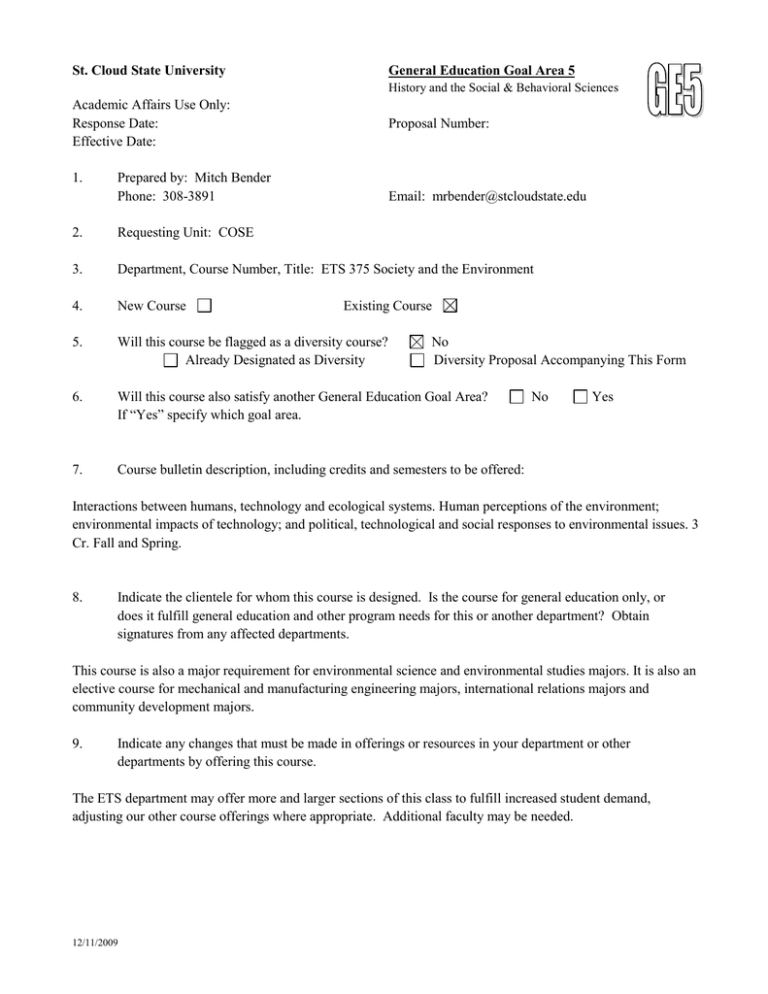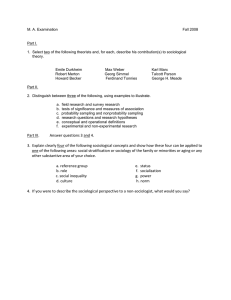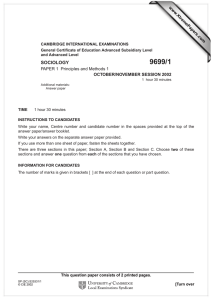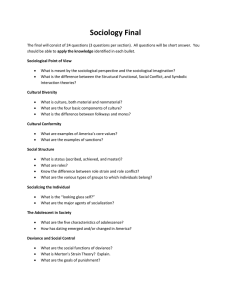Academic Affairs Use Only: Response Date: Proposal Number:
advertisement

St. Cloud State University General Education Goal Area 5 History and the Social & Behavioral Sciences Academic Affairs Use Only: Response Date: Effective Date: 1. Proposal Number: Prepared by: Mitch Bender Phone: 308-3891 Email: mrbender@stcloudstate.edu 2. Requesting Unit: COSE 3. Department, Course Number, Title: ETS 375 Society and the Environment 4. New Course 5. Will this course be flagged as a diversity course? Already Designated as Diversity 6. Will this course also satisfy another General Education Goal Area? If “Yes” specify which goal area. 7. Course bulletin description, including credits and semesters to be offered: Existing Course No Diversity Proposal Accompanying This Form No Yes Interactions between humans, technology and ecological systems. Human perceptions of the environment; environmental impacts of technology; and political, technological and social responses to environmental issues. 3 Cr. Fall and Spring. 8. Indicate the clientele for whom this course is designed. Is the course for general education only, or does it fulfill general education and other program needs for this or another department? Obtain signatures from any affected departments. This course is also a major requirement for environmental science and environmental studies majors. It is also an elective course for mechanical and manufacturing engineering majors, international relations majors and community development majors. 9. Indicate any changes that must be made in offerings or resources in your department or other departments by offering this course. The ETS department may offer more and larger sections of this class to fulfill increased student demand, adjusting our other course offerings where appropriate. Additional faculty may be needed. 12/11/2009 10. For new courses or courses not yet approved for General Education, indicate any other SCSU departments or units offering instruction that relates to the content of the proposed course. BIOL 101 Environment and Society. 11. Courses designated as General Education are included in the assessment plan for the Goal Area(s) for which they are approved. Courses for which assessment is not included in the annual GE assessment report for two years will be removed from the General Education Program. The Requesting Unit understands and recognizes the above conditions. 12. Provide a concise explanation of how the following goal is a “significant focus” of the proposed course. Goal Area 5: History and the Social & Behavioral Sciences Develop understanding of human societies and behaviors, and of the concepts, theories, and methods of history and the social sciences. ETS 375 investigates the interactions between society and the environment. The course analyzes soci-cultural perceptions of the environment, environmental impacts of technology and political, technological, and social responses to environmental issues. More specifically, students will examine environmentalism as a social movement and will investigate: 1) structures of socio-cultural systems, 2) various classifications of culture (real, ideal, material, symbolic, etc.), 3) relationships between biological and cultural systems, 4) cognized environments (views of one’s environment based on cultural perspectives), 5) societal changes from hunters and gatherers to an industrial society (including changes in family structures, subsistence/non-subsistence roles, gender roles, etc.), 6) social, historical, political and economic factors leading to globalization, 7) concepts of environmental and social justice (particularly comparing the actions of more developed countries to those of lesser developed countries), 8) influences of society and culture on consumption, population growth, food production, energy use and transportation use (much of this is a comparison of self-reflection and student collected data with known data). 13. In order for a course to be designated as fulfilling Goal Area 5, it must address at least 4 of the 5 student learning outcomes (SLOs) below. Check the SLOs below that are focused on in the proposed general education course. 1. Describe or use the methods and data by which historians, social scientists, or behavioral scientists investigate human conditions. 2. Analyze human behavior, cultures, and social institutions and processes from the perspectives of history or the social and behavioral sciences. 3. Develop explanations for and explore solutions to historical or contemporary social problems. 12/11/2009 4. Reflect upon themselves in relation to family, communities, society, culture, and/or their histories. 5. Apply and critique alternative explanatory systems or theories about human societies and behaviors. 14. Discuss how each Student Learning Outcome checked above is achieved in this course. (Note: Although descriptions of typical assignments or types of assignments may be part of this discussion, it is not appropriate to submit copies of actual assignments.) SLO 2. Analyze human behavior, cultures, and social institutions and processes from the perspectives of history or the social or behavioral sciences. Students investigate U.S. and St. Cloud resource, food and energy consumption rates, as well as transportation use and compare to global rates and use. This is done primarily through a comparison of self-reflection and student collected data with known data. Examples of assignments include surveying food selections in local grocery stores, interviewing family members and friends about the 1970s energy crisis and analyzing advertisement in their favorite T.V. shows. Students integrate into discussions and essays known sociological, cultural and environmental data with their own student collected data and self-reflection. Within these discussions and essays, students incorporate their understanding of: 1) structures of socio-cultural systems, 2) various classifications of culture (real, ideal, material, symbolic, etc.), 3) relationships between biological and cultural systems, 4) cognized environments (views of one’s environment based on cultural perspectives), 5) societal changes from hunters and gatherers to an industrial society (including changes in family structures, subsistence/non-subsistence roles, gender roles, etc.), 6) social, historical, political and economic factors leading to globalization, 7) concepts of environmental and social justice (particularly comparing the actions of more developed countries to those of lesser developed countries), 8) influences of society and culture on consumption, population growth, food production, energy use and transportation use (much of this is a comparison of self-reflection and student collected data with known data) 9) as well as environmentalism as a social movement. SLO 3. Develop explanations for and explore solutions to historical or contemporary problems. Students will investigate throughout the semester a sociological/environmental issue of their choice. An example of an assignment is constructing, administering and analyzing a sociological survey on their chosen issue. Topics such as recycling, invasive species effects on fishing, mass transportation issues and the use of renewable energy in society are common choices. 12/11/2009 These surveys are administered to St. Cloud State University students. This student collected data is then compared to known data from other sociological and environmental studies and conclusions and recommendations are made by the students with regards to their chosen sociological/environmental issue. In some sections of this course, students may participate in a service learning project. An example of a current service learning project has been developing an ‘Adopt-A-Block’ program, where the class works to recruit student organizations to adopt a block near campus. The student organizations not only clean their adopted blocks, but seek ways to prevent litter and other undesirable issues in the neighborhood. In this way, students in the class again work with the university population to evaluate a sociological/environmental issue in their community and work to resolve the issue. SLO 4. Reflect upon themselves in relation to family, communities, society, culture, and /or their histories. Students will reflect on personal resource, food and energy consumption rates, as well as transportation use in class discussions and in homework assignments. Within their discussions and essays they integrate known sociological, cultural and environmental data with their own student collected data and self-reflection. SLO 5. Apply and critique alternative explanatory systems or theories about human societies and behaviors. Students will evaluate technological, economic and sustainable options to issues related to consumption, population growth, food production, transportation and energy use in class discussions and in homework assignments. Students will critique two sociological/environmental future theories: a future without limits and a future with limits. 15. List or attach the Course Outline (adequately described and including percentage of time to be allocated to each topic). Curriculum Committees may request additional information. Topics larger than 20% need to be broken down further. Indicate in your course outline where the Student Learning Outcomes checked above are being met. 1. Introduction/review of the concepts of ecosystems, culture, and social systems. 5%. Student learning outcome 2. 2. History of societies: hunters and gatherers to a global society. Comparison of culture, cognized environments, economies, technology, resource use, family structure, gender roles, healthcare, etc. among hunters and gatherers, agricultural and industrial societies. 10% 3. Current state of natural resources. 5%. 4. Discussion of the principles of sustainability. 5%. 5. Introduction of the concepts of environmental and social justice. 5%. Student learning outcomes 2, 3. 6. Resource consumption, society and the environment. Comparison of U.S. and global rates of consumption. Reflection on personal consumption rates. Evaluation of technological, economic, sustainable options to issues related to consumption. 12%. Student learning outcomes 2, 3, 4. 12/11/2009 7. Population, society and the environment. Comparison of U.S. and global rates of population growth. Evaluation of technological, economic, sustainable options to issues related to population growth. 12%. Student learning outcomes 2, 3, 4. 8. Food, society and the environment. Comparison of U.S. and global food resources and production. Reflection of personal food consumption. Evaluation of technological, economic, sustainable options to issues related to food production. 12%. Student learning outcomes 2, 3, 4. 9. Transportation, society and the environment. Comparison of U.S. and global transportation resources and use. Reflection of personal transportation use. Evaluation of technological, economic, sustainable options to issues related to food production. 12 %. Student learning outcomes 2, 3, 4. 10. Energy, society and the environment. Comparison of U.S. and global energy resources and use. Reflection of personal energy use. Evaluation of technological, economic, sustainable options to issues related to food production. 12%. Student learning outcomes 2, 3, 4. 11. Alternative futures. Summary of technological, economic, sustainable options to environmental and societal issues. 10%. Student learning outcome 5. 12/11/2009 St. Cloud State University General Education Transmittal Form Academic Affairs Use Only: Response Date: Effective Date: Proposal Number Department: Course or Course(s): Department or Unit Chair Signature Date Department forward to Academic Affairs for publication and electronically to Chair of General Education Committee, Chair of College Curriculum Committee, College Dean Recommendation of General Education Committee: Approve Remarks: Disapprove Chairperson Committee Signature Date Recommendation of University Curriculum Committee: Approve Remarks: Disapprove Chairperson Committee Signature Date Recommendation of Faculty Association: Approve Remarks: Disapprove FA Senate Signature Date Action of Academic Vice President: Approve Disapprove Signature Entered in Curriculum Data File 12/11/2009 Remarks: Date



